A Journey To Create The Perfect Pocket Square
At Rampley & Co we pride ourselves on producing the best possible quality products through innovative design, the best available fabrics and quality craftsmanship. In terms of creating beautiful pocket squares, there are four key elements that make up the design process; material, design, finish and size. Below we have laid out exactly what we feel makes a luxury pocket square and why we feel we make the finest silk pocket squares in the world.
Below we've created a short video outlining everything that goes into creating our luxury pocket squares. You can view our full range here: Pocket Square Collection.
Material
The material chosen for the pocket square (or handkerchiefs as they’re sometimes referred) is incredibly important and there are a variety of options available that work for both, namely silk, linen, cotton and wool-silk blends. The majority of our collection are silk pocket squares, with some silk-wool blends to add texture, and we have therefore spent a lot of time ensuring that the silk we source is of the finest quality for the intricate patterns and designs we often use.
We have therefore devoted a lot of our energy to finding the perfect weight and weave for our pocket squares, which is a very fine mulberry silk twill with 100% silk filament. This gives our products the beautiful soft feel that people associate with high-quality silk products while allowing the design to bleed through evenly on both sides, which we feel is the hallmark of a top quality accessory. We have also laid out below how our silk is produced and printed to create our luxurious silk pocket squares.


One aspect that a lot of consumers don’t tend to consider is the ‘bleed’ of the pocket square. This is affected by both the weight of the material that you are using but also by the style of printing. When hand printing you tend to find you get much better penetration of the ink through the fabric but you are unable to get the level of detail and colour blend required if trying to print a piece of fine art onto silk.
As we need to digitally print our paintings we needed to find the right weight of silk that would allow us to get the penetration of ink onto the reverse of the square (essentially when showing out of your pocket) while also having the right structural integrity to allow a rigid fold and avoid slippage in the pocket. For this reason, we decided upon a 15OZ weight of 100% silk which we feel is the perfect blend.
If you’re trying to introduce a bit of texture, then a wool-silk blend is the high-end choice when looking for a more casual look and feel but while retaining the feel of luxury.


Design
As a company, we’re always trying to work with some of the most prestigious and well-known institutions, museums, galleries, artists and designers to provide our customers with truly unique designs. It is our aim to provide pieces of art in your pocket while continuing to innovate and find new ways of presenting this timeless classic as well as paying a premium to ensure we have the best quality product available.
When identifying a partner to work with we always take great care to ensure that they are in line with our brand values as well as making sure that the partnership is in keeping with the style of product we’re looking to create and that the imagery we’re using is the right fit. With The National Gallery for example, we worked closely with their team to choose a selection of paintings from their collection of thousands of some of the finest artworks in the world.
The paintings had to first and foremost suit the medium on which they were to be presented and so we slowly identified those we wanted based on colour blends and the ability to work within a square crop. We then designed unique borders for each square, each inspired by the painting it was chosen to go with and utilising individual details seen in the work such as the detailing on an arch or the colouring of a piece of clothing.
Below is the Crivelli painting The Annunciation, With Saint Emidus as seen in the National Gallery which we have used as a design on one of our pocket squares.

Once designs were finalised we worked with their expert colourist to ensure that the sampling process gave us the closest possible match to the original painting before producing our finished product. This is a difficult task when printing complicated images with multiple colour blends onto silk but fully worth it when presented at the end with a stunning hand rolled silk pocket square featuring an absolutely stunning piece of art.
The Finish - Hand rolled vs Machine hems
To really ensure you have a truly luxury pocket square you really need to look carefully at the way the edges of the pocket square are finished. We would always recommend that you have a hand rolled hem as this is the only way to give you the best possible look when folding the pocket square for your sports jacket, blazer or suit. The process of hand rolling ensures that you have a nice plump finish all along the edge of your square and this will act as a way of providing structural integrity to your square when folded.
With machine finished hems, you will find that you end up with a very flat edge as it has been slightly pressed down by the machine. This can cause the corners of your square to droop when sticking from your pocket but also flattens the square in general when folded and so you may also find you get slippage within the pocket, especially if moving around at pace, and so you’ll have to keep having to fish your pocket square out and readjust!



Pocket Square Size
We spent a long time deciding what size our pocket squares should be but found that it is often dependent on the material that you’re using. Effectively, you want the right balance between a large enough square to provide some structural integrity when in the pocket (thus again avoiding slippage as with the hand rolled hems) while avoiding the puffing effect that this can have on some jacket pockets.
What you tend to find with some retailers of lower quality squares is that they will be 30x30cm or 33x33cm when finished and this is often down to the fact that they can produce more per length of silk/linen and therefore increase margins. In terms of silk pocket squares, we felt that the only way to have a truly luxury product was to produce the size that would best suit the needs of the customer and so we finish ours at 42x42cm.
The process of printing the silk is extremely important, the right ink and the right materials will make a truly beautiful product. Here's a look at the process in more detail.
Preparing The Silk
Firstly, the skeins of raw silk are categorised by colour, size, and quantity and then soaked in warm water mixed with oil or soap to soften the sericin before being dried.
As the silk filaments are reeled onto bobbins, they are twisted in a particular manner to achieve a certain texture of yarn. For instance, "singles" consist of several filaments which are twisted together in one direction. For our silk squares and scarves, they are turned tightly to create a sheer fabric which is the hallmark of soft silk products.
The silk yarn is then put through rollers to make the width more uniform. It is then inspected and weighed to ensure the final product is of a consistently high standard.

Our Unique Printing and Finishing Process
To achieve the distinctive softness and shine of silk, the remaining sericin in the silk must be removed from the yarn by soaking it in warm soapy water. This process known as 'degumming' decreases the weight of the yarn by as much as 25%.
Next, we coat the silk twill through a bath with rollers that irons and dries the fabric as it goes through. This coating process ensures that the acid inks print onto the cloth as optimally as possible.
The cloth is then weft straightened, a process where the fabric goes through a rolling machine to ensure that the warp threads (vertical threads) and weft (horizontal threads) are running perpendicular to each to create a straight piece of fabric ready for printing.
The silk cloth is then printed, which depending on the design is either screen printed or digitally printed, which we go into in more detail below. The final part of this stage of the process is steaming the cloth.

The combination of the chemicals from the coating, the speciality inks used and then the steaming process fixes the inks to the silk. The silk is then washed and we add products to the water which wash away any excess inks and fix the inks permanently. At this stage, we add a special recipe of softeners to finish the cloth.
The silk cloth then has a final weft straighten before being cut, hand rolled and sewn to complete the finished pocket square or scarf.
The Weight and Type of Silk
We have tested a number of silk weights in order to get the perfect weight for our pocket squares and scarves. Firstly, the weight of the silk determines how the fabric performs as a fashion accessory. Too light, and the silk is not heavy enough to have any sort of structure, so will not support more prominent folds for pocket squares and will drape limply with scarves.



If however the silk it too heavy, the ink cannot penetrate right through the silk which leaves a prominent design on one side, but a washed out pattern on the back. It is our opinion that the hallmark of a premium silk product is one where the design is almost as sharp and vibrant on the back as it is on the front. Particularly as having the design on both sides means you are not limited in your fold choices for pocket squares or how it is tied with scarves.

Screen Printing vs Digital Printing
We use both screen printing and digital printing with our silk products, and the choice of which one to use comes down to the design of the product itself.
We do love the history and craftsmanship that goes into screen printing which originated in China more than 1000 years ago before being introduced to Europe in the late 18th century. However, due to the nature of the screen printing process, you can only work with a limited number of inks, while the design can’t be overly intricate. Digital printing means we can literally have hundreds of colours and produce extremely fine detail that are the hallmarks of many of the works we use in our products.
Digital printing, as you would expect, uses a more advanced type of printer that is able to print directly onto fabric, with exquisite detail and myriad colours.
Click here to view our full range of Hand Rolled Pocket Squares.

